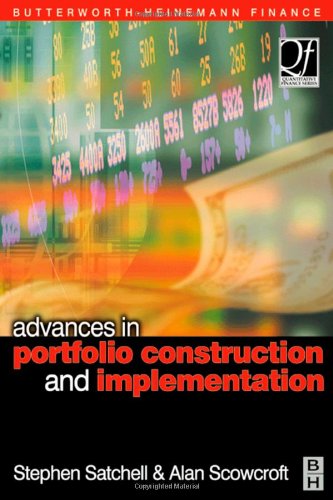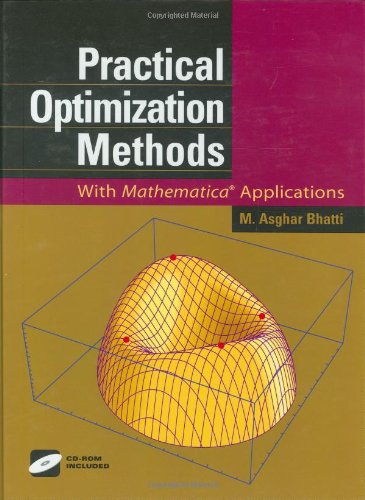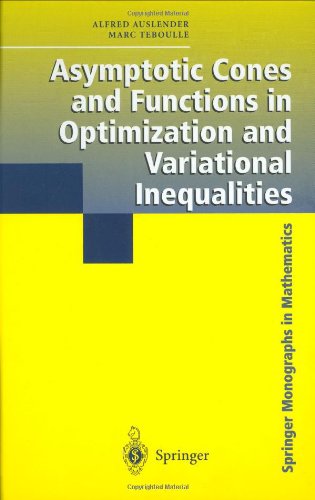Alan Scowcroft, Stephen Satchell0750654481, 9780750654487, 9781417507634
Table of contents :
Contents……Page 6
Contributors……Page 12
Introduction……Page 18
1 A review of portfolio planning: models and systems……Page 19
1.1 INTRODUCTION AND OVERVIEW……Page 20
1.2.1 The markowitz mean-variance model and the risk-return frontier……Page 22
1.2.2 Models with diagonal quadratic form as objectives……Page 24
1.2.3 The mean-absolute deviation (MAD) model……Page 28
1.2.4 The goal programming model……Page 29
1.2.5 The minimax model (MM)……Page 31
1.3.1 Sources of risk and choice of appropriate measures: risk dilemmas……Page 32
1.3.2 A generic approach to risk representation and quantification……Page 33
1.4.1 Buy-in thresholds for assets……Page 36
1.4.3 Roundlot transactions……Page 37
1.4.4 Portfolio dedication……Page 38
1.4.5 Portfolio immunization……Page 39
1.5 PREPARATION OF DATA: FINANCIAL DATA MARTS……Page 40
1.6 SOLUTION METHODS……Page 43
1.7.1 Modelling and the solution tools……Page 45
1.7.2 DCEF study for five stock indices……Page 46
1.7.3 Experience with UBSW-PAS models……Page 47
1.9 APPENDIX 1: PIECEWISE LINEAR APPROXIMATION OF THE QUADRATIC FORM……Page 50
1.10 APPENDIX 2: COMPARATIVE COMPUTATIONAL VIEWS OF THE ALTERNATIVE MODELS……Page 52
REFERENCES 1……Page 55
ACKNOWLEDGEMENTS 1……Page 57
2 Generalized mean-variance analysis and robust portfolio diversification……Page 58
2.1 INTRODUCTION……Page 59
2.2 GENERALIZED MEAN-VARIANCE ANALYSIS……Page 62
2.3 THE STATE PREFERENCE THEORY APPROACH TO PORTFOLIO CONSTRUCTION……Page 64
2.4 IMPLEMENTATION AND SIMULATION……Page 66
2.5 CONCLUSIONS AND SUGGESTED FURTHER WORK……Page 71
REFERENCES 2……Page 72
3 Portfolio construction from mandate to stock weight: a practitioner’s perspective……Page 73
3.1 INTRODUCTION……Page 74
3.2.3 Mathematics……Page 76
3.2.4 Prototype implementation……Page 78
3.2.6 Conclusions……Page 79
3.3.2 Deriving the distance measure……Page 82
3.3.3 Initial empirical tests……Page 83
3.3.4 The 10 stock portfolio……Page 85
3.3.5 The other extreme: the index fund……Page 89
3.3.6 Intermediate portfolios……Page 90
3.3.8 Very large funds……Page 93
3.3.9 Bets at the industry level and their influence on tracking error……Page 94
3.3.11 Flight envelopes for correlated regional equity markets, with particular reference to emerging markets……Page 97
3.4 ACTIVE CAPM, OR HOW FAR SHOULD A BET BE TAKEN?……Page 100
3.5.1 Introduction……Page 107
3.5.2 Rationale and approach……Page 108
3.5.4 Results: model problem……Page 109
3.6 CONCLUSIONS……Page 110
REFERENCES AND FURTHER READING 3……Page 112
4 Enhanced indexation……Page 113
4.1.1 Enhanced index funds……Page 114
4.2 CONSTRUCTING A CONSISTENT VIEW……Page 115
4.2.1 Theil-Goldberger mixed estimator……Page 117
4.3 ENHANCED INDEXING……Page 121
4.3.1 Our definition of enhanced indexing……Page 123
4.4 AN ILLUSTRATIVE EXAMPLE: TOP-DOWN OR BOTTOM-UP?……Page 124
4.4.1 The strategistsÌ forecasts……Page 126
4.4.2 A comparison of asset allocation v stock selection……Page 127
4.4.3 Simplifying the design process……Page 134
4.5 CONCLUSIONS……Page 137
4.6 APPENDIX 1: DERIVATION OF THE THEIL-GOLDBERGER MIXED ESTIMATOR……Page 138
4.7 APPENDIX 2: OPTIMIZATION……Page 139
REFERENCES 4……Page 141
NOTES 4……Page 142
5.1 INTRODUCTION……Page 143
5.2 DO TAXES REALLY MATTER TO INVESTORS AND MANAGERS?……Page 144
5.3 THE CORE PROBLEMS……Page 145
5.4 THE STATE OF THE ART……Page 146
5.5 THE MULTI-PERIOD ASPECT……Page 148
5.7 AFTER-TAX BENCHMARKS……Page 150
REFERENCES 5……Page 151
6.1 LIMITATIONS OF TRADITIONAL MEAN-VARIANCE PORTFOLIO OPTIMIZATION……Page 153
6.2 SELECTING A METHOD TO LIMIT THE NUMBER OF SECURITIES IN THE FINAL PORTFOLIO……Page 159
6.3.1 Design and implementation of the genetic algorithm……Page 163
6.3.2 Optimization of performance……Page 165
6.4 PERFORMANCE OF GENETIC ALGORITHM……Page 168
6.5 CONCLUSIONS……Page 176
REFERENCES 6……Page 177
7 Near-uniformly distributed, stochastically generated portfolios……Page 179
7.1 INTRODUCTION – A TRACTABLE N-DIMENSIONAL EXPERIMENTAL CONTROL……Page 180
7.2.1 Constraint evaluation……Page 181
7.2.4 Portfolio attribute benchmarking……Page 182
7.3.2 Definitions……Page 183
7.3.4 Asset patterns – reducing the size of the problem……Page 184
7.3.6 Monte Carlo solutions……Page 185
7.3.7 Pattern constraints……Page 186
7.3.8 Generating a Monte Carlo portfolio……Page 189
7.3.10 Number of holdings in a Monte Carlo portfolio……Page 190
7.4.1 Three asset results……Page 191
7.5 PROBLEMS AND LIMITATIONS WITH DYNAMIC CONSTRAINTS ALGORITHM……Page 192
7.6.2 Algorithm description……Page 193
7.7 RESULTS OF THE DYNAMIC CONSTRAINTS WITH LOCAL DENSITY CONTROL……Page 198
7.9 FURTHER WORK……Page 203
7.10 APPENDIX 1: REVIEW OF HOLDING DISTRIBUTION IN LOW DIMENSIONS WITH MINIMAL CONSTRAINTS……Page 204
7.11 APPENDIX 2: PROBABILITY DISTRIBUTION OF HOLDING WEIGHT IN MONTE CARLO PORTFOLIOS IN N DIMENSIONS WITH MINIMAL CONSTRAINTS……Page 207
7.12 APPENDIX 3: THE EFFECTS OF SIMPLE HOLDING CONSTRAINTS ON EXPECTED DISTRIBUTION OF ASSET HOLDING WEIGHTS……Page 208
7.13 APPENDIX 4: PROPERTIES OF HYPER-SOLIDS……Page 209
NOTES 7……Page 210
8.1 INTRODUCTION……Page 211
8.2 MEAN AND VARIANCE OF DIRECTIONAL STRATEGIES……Page 212
8.3 CORRELATION WITH TRACKER FUND……Page 214
8.4 PARAMETERS ESTIMATION……Page 216
8.5 OPTIMAL ALLOCATION……Page 217
8.5.1 Optimal long/short fund on the index itself……Page 219
8.5.2 Optimal allocation between an index and the maximum return long/short futures fund……Page 221
8.5.3 Optimal allocation between an index and a long/short futures fund……Page 223
8.6 AN EMPIRICAL APPLICATION TO THE CURRENCY MARKETS……Page 225
8.7 CONCLUSIONS……Page 226
8.8 APPENDIX 1: MEAN AND VARIANCE OF DIRECTIONAL STRATEGIES……Page 227
8.9 APPENDIX 2: CORRELATION WITH TRACKER FUND……Page 228
8.10.1 Optimal allocation between an index and the maximum return long/short futures fund……Page 230
REFERENCES 8……Page 231
ACKNOWLEDGEMENTS 8……Page 232
9.1 INTRODUCTION……Page 233
9.2 HOW TO MEASURE MARKET AND CREDIT RISK……Page 234
9.3 THE WAYS OF CONSTRUCTING LOSS DISTRIBUTIONS……Page 236
9.4.1 Liquidity component……Page 238
9.4.2 Probability of default……Page 239
9.4.3 Recovery rate……Page 241
9.4.4 Value of the firm approach9……Page 242
9.4.5 Rating transition matrix approach……Page 244
9.5.1 Modelling joint defaults……Page 245
9.5.2 Monte carlo simulation of portfolio values……Page 246
9.5.3 Optimizing portfolio credit risk profile……Page 248
9.6 CONCLUSIONS……Page 250
9.7 APPENDIX……Page 251
9.7.1 Random reformulation of the initial problem and the first order variation of the objective functional……Page 252
9.7.2 The concept of gradient in the non-smooth extreme problem……Page 253
9.7.3 Constructing optimization algorithm……Page 255
REFERENCES……Page 258
NOTES……Page 260
10.1 INTRODUCTION……Page 261
10.2 THE ALGEBRA OF MULTIVARIATE MOMENTS……Page 264
10.3 THE PORTFOLIO FRONTIER: EXPECTED RETURN, SKEWNESS AND KURTOSIS……Page 266
REFERENCES 10……Page 274
NOTES 10……Page 275
11.1 INTRODUCTION……Page 276
11.2 SOME BASICS……Page 277
11.2.1 Constant proportions and optimal growth……Page 278
11.3 ACTIVE PORTFOLIO MANAGEMENT……Page 279
11.3.1 The incomplete market case: diffusion minimization and probability maximization……Page 280
11.3.2 Minimizing/maximizing expected time……Page 281
11.3.3 Active Portfolio Management: the complete market case with p2=1……Page 282
11.4 TRADING OFF RISK AND RETURN IN ACTIVE PORTFOLIO MANAGEMENT: FRACTIONAL OBJECTIVES……Page 283
11.5 RISK-CONSTRAINED MINIMAL TIME……Page 284
REFERENCES 11……Page 286
12.1 INTRODUCTION……Page 287
12.2 OPTIMAL PORTFOLIO WITH RANKS……Page 288
12.2.1 Mean and variance- covariance matrix of ranks……Page 289
12.2.2 The optimal rank portfolio……Page 290
12.3.1 Properties of ranks……Page 291
12.3.2 The optimal rank portfolio: short sale allowed……Page 295
12.3.3 The optimal rank portfolio: short sale not allowed……Page 301
12.3.4 The effects of the number of the rank portfolio……Page 304
12.4 CONCLUSIONS……Page 306
NOTES 12……Page 307
13.1 INTRODUCTION……Page 308
13.2 THE MEAN-DSR PORTFOLIO FRONTIER: THE TRADITIONAL APPROACH……Page 311
13.3 THE MULTIVARIATE CASE……Page 315
13.4 A KERNEL APPROACH……Page 317
13.5 THE KERNEL APPROACH TO THE MULTIVARIATE CASE……Page 321
13.6 THE MEAN-DSR PORTFOLIO FRONTIER USING KERNEL ESTIMATES……Page 323
13.7 ASSET PRICING……Page 324
REFERENCES 13……Page 326
14.1 INTRODUCTION……Page 328
14.2 PROPERTIES OF THE RISK ESTIMATOR……Page 331
14.3 PROPERTIES OF THE ESTIMATED PORTFOLIO WEIGHTS……Page 335
14.4 THE RISKLESS ASSET CASE……Page 339
14.6 APPENDIX: THE UNCONDITIONAL MEAN OF ALPHA……Page 341
NOTES 14……Page 343
15.1 INTRODUCTION……Page 344
15.2 THE ASSET ALLOCATION MODEL……Page 345
15.3 AN ILLUSTRATIVE EXAMPLE……Page 347
ACKNOWLEDGEMENTS 15……Page 350
16.1 INTRODUCTION……Page 351
16.2.1 Models……Page 352
16.3 MODEL APPROACHES FOR RELATIVE PORTFOLIO OPTIMIZATION……Page 353
16.3.1 The Markowitz/Roll model……Page 354
16.3.4 The moment restricted model……Page 355
16.3.6 An overview of the optimization models……Page 356
16.4 DISCUSSION OF THE MODELS……Page 357
REFERENCES 16……Page 358
NOTES 16……Page 359
17.1 INTRODUCTION……Page 360
17.2 EFFICIENT SET MATHEMATICS FOR GIVEN MU AND V……Page 362
17.3 THE EFFECT OF FORECASTS……Page 365
17.4 MODEL AND PROCESS……Page 366
17.5 DATA AND EMPIRICAL RESULTS……Page 367
17.7 APPENDIX: EFFECT OF ESTIMATION ERROR IN MU……Page 370
NOTES 17……Page 372
ACKNOWLEDGEMENTS 17……Page 373
Index……Page 374







Reviews
There are no reviews yet.